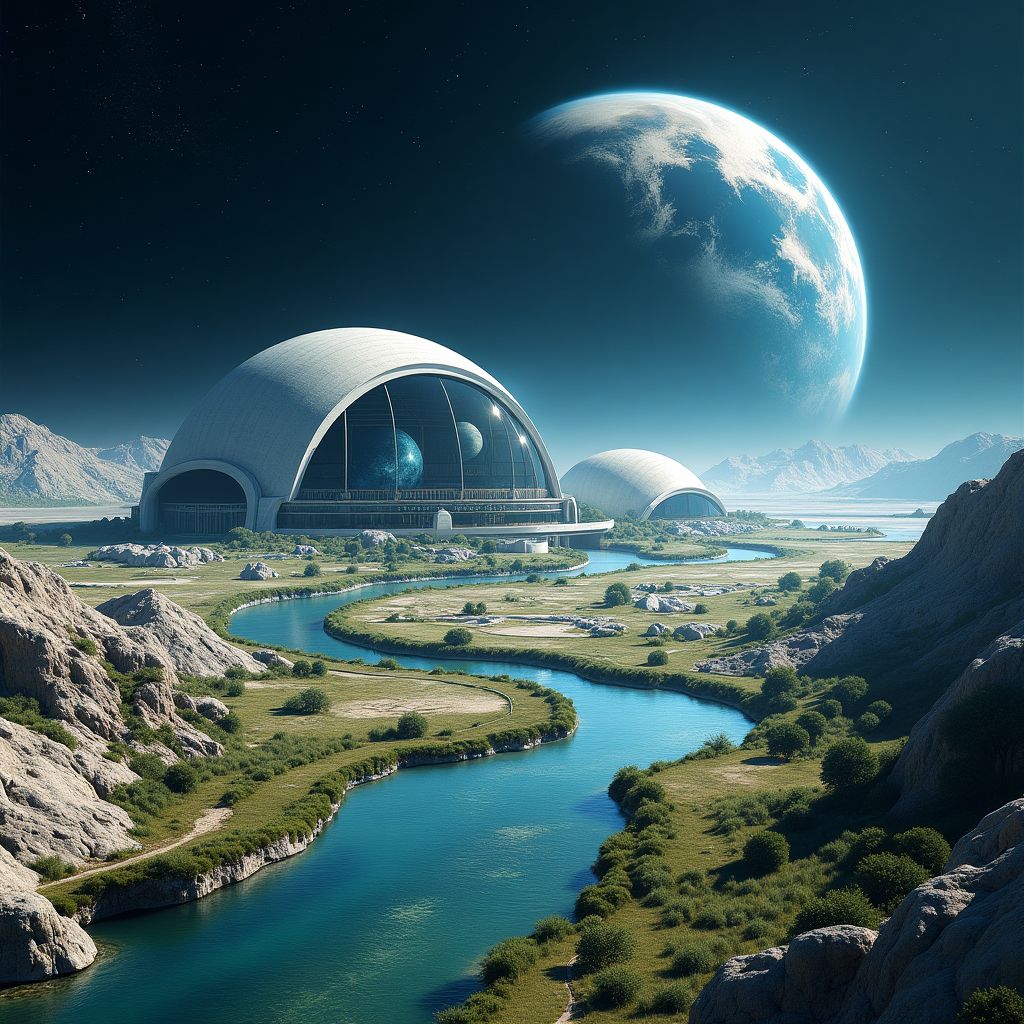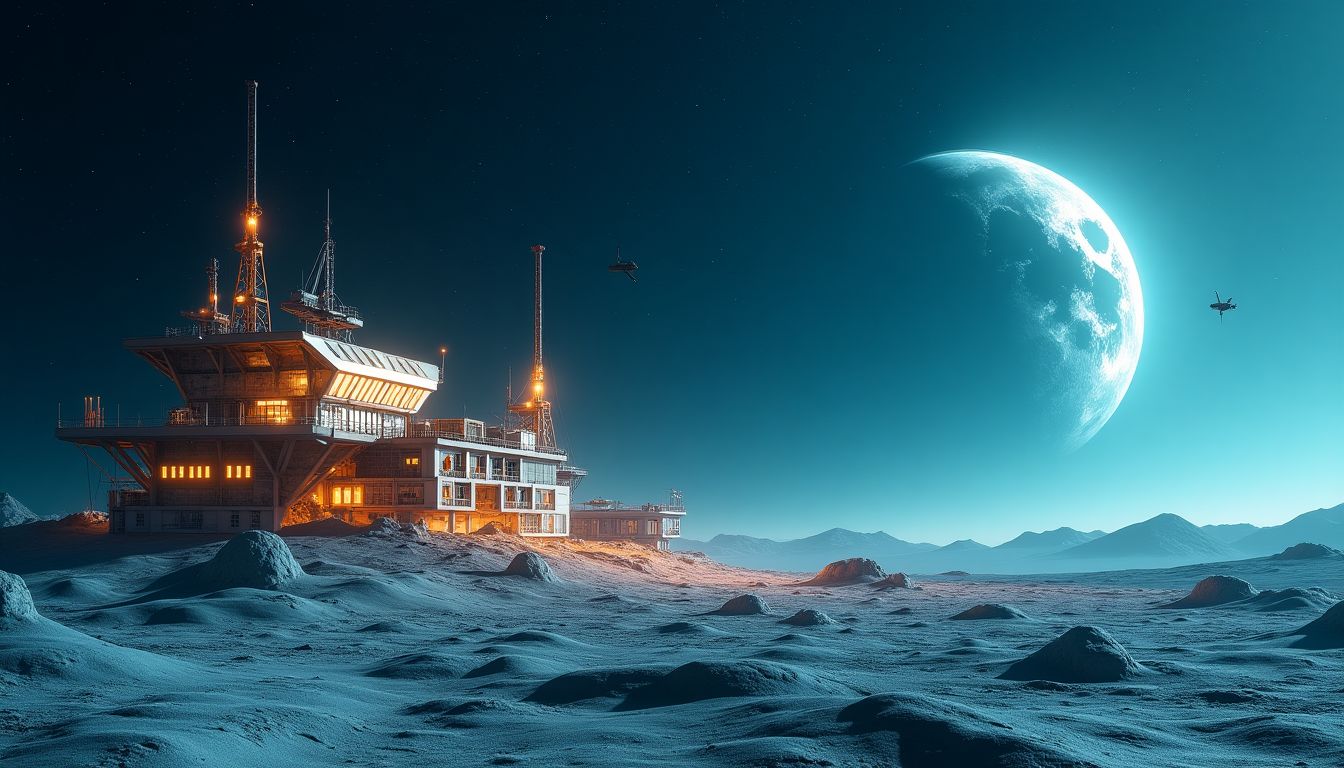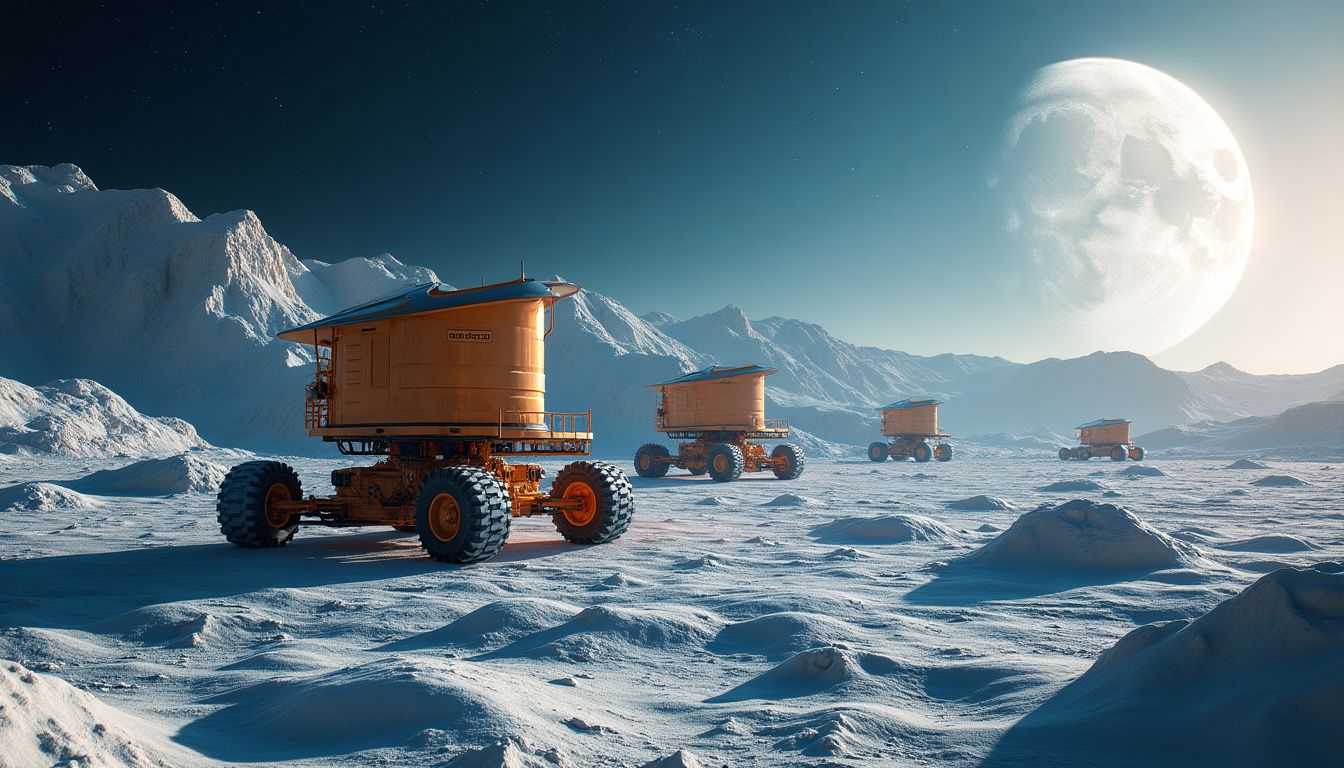What if the Moon, Earth’s silent companion for billions of years, could become humanity’s first extraterrestrial home? Imagine artificial intelligence (AI) systems transforming the barren lunar landscape into thriving, sustainable cities where humans live, work, and explore. Is this the ultimate frontier for human civilization, or just a sci-fi fantasy? For decades, the Moon has captivated humanity as a symbol of exploration and possibility. From the poetic musings of Carl Sagan to the visionary ideas of Elon Musk, the idea of lunar colonization has been both a dream and a challenge. Even NASA’s Apollo missions, which first brought humans to the Moon, were just the beginning of what could be a monumental chapter in human history.
With advancements in AI, robotics, and space technology, the dream of lunar colonization is no longer confined to the pages of science fiction. Today, researchers like Dr. Angela Martin of MIT are exploring how AI could lead the charge in terraforming the Moon, creating the first sustainable lunar cities for human habitation. But how do we turn this vision into reality? What are the challenges, opportunities, and groundbreaking AI-driven solutions that could make this possible? And, perhaps most importantly, why should we even bother? This article dives into these questions, exploring how AI could help humanity take its first steps toward becoming an interplanetary species.
1. The Vision: Why Lunar Colonization Matters
1.1 Humanity’s Next Frontier
The Moon isn’t just a glowing orb in the night sky—it’s humanity’s next frontier. Think of it as the ultimate fixer-upper project. Instead of flipping houses, we’re flipping a celestial body. But why the Moon? For starters, it’s the closest celestial body to Earth, making it the perfect stepping stone for deeper space exploration. If we can figure out how to live on the Moon, Mars and beyond suddenly don’t seem so far-fetched. Plus, with Earth’s population booming and resources dwindling, the Moon offers a fresh start. It’s like moving to a new neighborhood, but with zero gravity and a killer view.
Scientific and technological advancements spurred by lunar colonization could revolutionize life on Earth. From new energy sources like helium-3 to innovations in construction and agriculture, the Moon could be a goldmine of opportunity. And let’s not forget the sheer audacity of it all—building cities on the Moon is the kind of bold move that could inspire generations to dream bigger and aim higher.
1.2 Challenges of Lunar Habitation
Of course, living on the Moon isn’t exactly a walk in the park. First, there’s the lack of atmosphere. No air means no breathable oxygen, and no protection from harmful radiation. Then there are the extreme temperatures—think boiling hot during the day and freezing cold at night. And let’s not forget the limited resources. Water is scarce, and what little exists is locked away in ice. Building anything requires hauling materials from Earth or figuring out how to use the Moon’s own regolith (that’s fancy talk for lunar dirt).
Even if we solve the technical challenges, there’s the human factor. Living in isolation, far from Earth, could take a toll on mental health. Plus, the logistics of keeping a lunar colony running smoothly are mind-boggling. But hey, nobody said pioneering was easy.
1.3 The Role of AI in Overcoming These Challenges
Enter AI, the ultimate problem-solver. Artificial intelligence systems could revolutionize lunar colonization by processing vast amounts of data, optimizing solutions, and autonomously managing complex tasks. From designing habitats to managing resources, AI could take the guesswork out of lunar living. Imagine robots building cities, AI systems recycling water and oxygen, and algorithms predicting and preventing potential disasters. AI could be the secret sauce that makes lunar colonization not just possible, but practical.
2. AI-Driven Resource Extraction and Utilization
2.1 Mining Lunar Resources
When it comes to mining on the Moon, AI is the ultimate space prospector. Forget gold—water ice, helium-3, and regolith are the real treasures. AI-powered robots, like those developed by NASA and SpaceX, could autonomously identify and extract these resources. Think of it as a robotic gold rush, minus the pickaxes and cowboy hats. For instance, water ice hidden in the Moon’s permanently shadowed craters could be the key to sustaining life and producing rocket fuel. AI algorithms would analyze data from lunar probes to pinpoint the best mining spots, ensuring we don’t end up digging in the wrong place—because getting lost on the Moon would be a lousy way to start a colony.
2.2 Sustainable Resource Management
On Earth, we’re notorious for waste, but on the Moon, every drop of water and every breath of oxygen counts. AI can help us create closed-loop systems where resources are recycled endlessly, kind of like a high-tech version of your grandma’s "waste not, want not" philosophy. Imagine AI-driven algorithms optimizing water and oxygen recycling, ensuring that nothing goes to waste. This isn’t just eco-friendly—it’s survival. Without AI, we’d be stuck hauling supplies from Earth, and let’s be honest, shipping costs to the Moon are probably through the roof.
2.3 Energy Production on the Moon
Let’s face it: solar power on the Moon is a no-brainer during the 14-day lunar day. But what about the equally long lunar night? Enter AI to save the day (and the night). AI-optimized solar arrays could maximize energy capture during the day, while advanced battery systems store that energy for the long, cold nights. For backup, nuclear energy solutions, like those being explored by NASA, could provide uninterrupted power. Imagine AI managing this lunar energy grid, ensuring that the lights stay on even when the Sun is on a break. After all, no one wants to binge-watch Netflix by candlelight on the Moon.
3. Designing Lunar Habitats: Architecture and Engineering
3.1 AI-Enhanced Habitat Design
Living on the Moon isn’t just about surviving—it’s about thriving. AI can help design habitats that are not only functional but also comfortable. Picture modular structures that expand as the colony grows, like a celestial LEGO set. AI-driven simulations would test designs against extreme lunar conditions—wild temperature swings, micrometeorite impacts, and radiation. The result? A Moon home that’s as cozy as your Earthly abode, minus the mortgage. Plus, AI could even incorporate green spaces using hydroponics, because even space explorers need a little zen to unwind after a long day of lunar gardening.
3.2 3D Printing and Construction
Forget shipping bricks to the Moon—AI and 3D printing can turn lunar regolith into building blocks. Companies like ICON are already experimenting with 3D-printed structures on Earth, and the Moon is the next logical step. AI-driven robots would extrude lunar soil into walls, domes, and even furniture, creating habitats layer by layer. It’s like having a giant, robot-controlled glue gun building your Moon mansion. The best part? No construction workers yelling at each other—just precise, efficient robots working in harmony.
3.3 Life Support Systems
Life support on the Moon is a delicate dance of air, water, and waste management, and AI is the choreographer. AI-managed systems would monitor air quality, recycle water, and process waste, ensuring that lunar settlers don’t end up in a smelly, oxygen-deprived nightmare. These systems would operate autonomously, with AI predicting and fixing issues before they become problems. Think of it as having a hyper-intelligent butler who ensures your air is fresh, your water is clean, and your waste is—well, not your problem anymore. It’s the ultimate in low-maintenance living, even if it’s millions of miles from Earth.
4. Building Lunar Infrastructure: Transportation and Communication
4.1 Lunar Transportation Networks
Moving around on the Moon won’t be as simple as hopping in a car. The lack of atmosphere and extreme terrain makes transportation a unique challenge. However, AI is poised to revolutionize how we get around on our lunar neighbor. AI-powered rovers and drones could become the lunar equivalent of taxis and delivery trucks, navigating the rocky surface with precision. These vehicles would rely on advanced computer vision and machine learning algorithms to avoid hazards and optimize routes.
For larger-scale mobility, lunar railways or magnetic levitation systems (maglev) could be developed. Imagine a high-speed train zipping across the Moon’s surface, powered by solar energy and managed by AI systems. Such a network would connect mining sites, habitats, and research stations, making the Moon feel more like a bustling small city than a desolate wasteland.
- Rovers: Autonomous vehicles for short-distance travel.
- Drones: Lightweight, agile machines for aerial surveys and deliveries.
- Maglev Trains: High-speed transport for long-distance travel.
4.2 Communication Systems
Staying connected on the Moon will require a robust communication network. Earth and the Moon are about 384,400 kilometers apart, which means even a simple phone call would face a 2.5-second delay. To bridge this gap, we’ll need a lunar internet—a network of satellites and ground stations that ensure seamless communication between Earth and the Moon.
AI will play a crucial role in optimizing these systems. For instance, AI algorithms could manage satellite networks, ensuring that data packets take the fastest routes and that bandwidth is allocated efficiently. This lunar internet would not only support day-to-day communications but also enable remote control of robots, real-time scientific collaboration, and even streaming entertainment for lunar residents.
- Lunar Satellites: Orbiting relays to ensure global coverage.
- AI Optimization: Smart algorithms for data routing and bandwidth management.
- Applications: Communication, remote operations, and entertainment.
4.3 Power Grids and Utilities
Powering a lunar city is no small feat. The Moon’s 14-day night cycle means solar panels alone won’t cut it. A decentralized energy grid, combining solar, nuclear, and battery storage, would be essential. AI could manage this grid, balancing supply and demand in real-time and predicting energy needs based on usage patterns.
Utilities like water and air would also rely on AI. Closed-loop systems, managed by intelligent algorithms, would recycle and purify resources continuously. For example, AI could monitor oxygen levels in habitats and adjust production to keep them safe and comfortable. These systems would ensure that lunar cities remain self-sufficient and sustainable, even in the harshest conditions.
- Energy Sources: Solar, nuclear, and battery storage.
- AI Management: Real-time monitoring and optimization.
- Utilities: Closed-loop systems for water and air recycling.
5. Human Adaptation and Governance on the Moon
5.1 Preparing Humans for Lunar Life
Living on the Moon won’t be easy. The lack of gravity, isolation, and extreme conditions pose significant physical and psychological challenges. AI could assist in preparing humans for this new environment. For instance, AI-powered health monitors could track vital signs and alert medical systems to any issues. Virtual reality (VR) simulations could help astronauts and settlers acclimate to lunar conditions before they even leave Earth.
Psychological support will also be critical. AI-driven counseling systems could provide mental health support, helping residents cope with the stress and loneliness of living far from home. Even recreational activities, like AI-curated entertainment or virtual social gatherings, could make life on the Moon more bearable.
- Health Monitoring: AI systems to track and respond to medical needs.
- Psychological Support: Counseling and entertainment systems to reduce stress.
- Training: VR simulations for acclimation.
5.2 Establishing Lunar Governance
Who will call the shots on the Moon? Governance will likely involve a mix of international collaboration and localized decision-making. AI could play a key role in managing resources, resolving disputes, and ensuring fair access to lunar facilities. For example, AI algorithms could allocate mining rights or distribute energy resources based on need and contribution.
Legal frameworks will also need to evolve. The Outer Space Treaty of 1967 established basic principles, but lunar cities will require more detailed regulations. AI could assist in drafting and enforcing these laws, ensuring that lunar settlements remain peaceful and productive.
- Resource Management: AI algorithms for fair allocation.
- Conflict Resolution: Smart systems to mediate disputes.
- Legal Frameworks: AI-assisted drafting and enforcement of laws.
5.3 Cultural and Social Development
The Moon’s first residents will create a unique culture unlike anything on Earth. AI could help foster this new identity by promoting collaboration and innovation. For example, AI-curated art and music programs could inspire creativity, while virtual reality platforms could bring people together for shared experiences.
Over time, lunar culture might blend elements from Earth's diverse traditions while developing its own distinct flavor. Holidays, rituals, and social norms could emerge, shaped by the Moon’s environment and the pioneering spirit of its inhabitants. AI would serve as a catalyst, facilitating connections and encouraging the growth of a vibrant lunar society.
- Art and Creativity: AI-curated programs to inspire innovation.
- Social Connection: VR platforms for shared experiences.
- Cultural Evolution: New traditions and norms shaped by the lunar environment.
6. AI Solutions: How Would AI Tackle This Issue?
6.1 Problem-Solving Framework
AI’s true power lies in its ability to simulate, optimize, and execute complex tasks with precision. For lunar colonization, AI will act as the architect, engineer, and overseer, ensuring every aspect of the mission is meticulously planned and executed. By integrating machine learning, robotics, and data analytics, AI can tackle challenges that would otherwise be insurmountable for human teams operating in such a hostile environment.
Imagine AI as the mastermind behind a lunar symphony, orchestrating everything from resource extraction to habitat construction. It will analyze data from satellites, rovers, and other sensors to create a comprehensive understanding of the Moon’s environment. This data will fuel AI algorithms that optimize everything from energy consumption to waste management, ensuring a sustainable and efficient lunar ecosystem.
6.2 Step-by-Step AI Strategies
Here’s how AI will lead the charge in building the first lunar cities:
- Data Collection and Analysis: AI will use satellites, rovers, and drones to gather detailed lunar data, including terrain maps, resource locations, and environmental conditions. This data will form the foundation for all subsequent steps.
- Resource Mapping: Using advanced algorithms, AI will identify optimal locations for water ice, helium-3, and regolith extraction. This step ensures efficient use of lunar resources.
- Habitat Design Optimization: AI will simulate various habitat designs, testing them against extreme lunar conditions to determine the most effective and durable structures.
- Autonomous Construction: Robots and 3D printers, guided by AI, will construct habitats, roads, and other infrastructure using lunar regolith and other materials. AI will ensure precision and efficiency in every task.
- Real-Time Monitoring: Once the lunar city is operational, AI systems will oversee all operations, from life support systems to energy grids, ensuring everything runs smoothly and safely.
6.3 Examples of AI Technologies
Several cutting-edge AI technologies will play a crucial role in lunar colonization:
- Neural Networks: These will be used for predictive modeling, helping AI anticipate issues like equipment failures or resource shortages before they occur.
- Reinforcement Learning: AI systems will use this to improve their decision-making capabilities over time, becoming more efficient at tasks like resource allocation and construction planning.
- Computer Vision: AI-powered robots will use this to navigate the lunar surface and perform precise construction tasks, such as welding or assembling habitat modules.
Action Schedule/Roadmap (Day 1 to Year 2)
Here’s a detailed roadmap for AI-driven lunar colonization:
- Day 1: Assemble a NASA-led global consortium of scientists, engineers, and AI experts to oversee the project.
- Week 1: Launch preliminary satellite missions to map lunar resources, including water ice and regolith deposits.
- Month 1: Develop AI algorithms for resource optimization, ensuring efficient extraction and utilization of lunar materials.
- Month 3: Begin testing AI-powered construction robots on Earth, simulating lunar conditions to refine their capabilities.
- Year 1: Launch the first AI-managed mission to extract lunar water ice, a critical resource for sustaining human life.
- Year 1.5: Establish a small-scale lunar habitat prototype, testing its durability and life support systems in a controlled environment.
- Year 2: Begin construction of the first permanent lunar city, using AI-driven robots and 3D printers to build infrastructure and habitats.
Key Players:
- Scientists: Elon Musk (SpaceX), Dr. Angela Martin (NASA), Prof. Hiroshi Tanaka (JAXA).
- Institutions: MIT, Caltech, European Space Agency.
- Projects: Artemis Program, Lunar Gateway, Blue Origin’s Moonbase Initiative.
Lunar Cities: A New Era for Humanity
The Moon has long been a symbol of humanity’s potential, a silent companion orbiting our planet for billions of years. But now, with the advent of AI, we’re on the brink of transforming that barren landscape into a thriving extension of human civilization. Lunar colonization isn’t just a dream; it’s a tangible goal, one that could redefine what it means to be human.
Imagine stepping out of a lunar habitat, the Earth hanging gracefully in the black sky above, a reminder of where we came from. Around you, AI-driven robots are bustling, constructing new buildings, managing energy grids, and ensuring the systems that keep you alive are running smoothly. This isn’t science fiction—it’s the future we’re building today.
But why stop at the Moon? AI’s role in lunar colonization is just the beginning. It’s a proving ground for the technologies and systems that will one day take us to Mars and beyond. By mastering the challenges of the Moon, we’re laying the groundwork for an interplanetary civilization, one where humanity thrives across the stars.
So, as we look to the future, let’s ask ourselves: What kind of humanity do we want to be? One confined to a single planet, or one that dares to explore, innovate, and build among the stars? The Moon is our first step, and with AI as our guide, the possibilities are endless.
Frequently Asked Questions
Q1: Is terraforming the Moon even possible?
While full terraforming—transforming the Moon into an Earth-like environment—isn’t achievable with current technology, creating habitable enclosures and sustainable systems is within reach. Projects like NASA’s Artemis Program and private initiatives by companies like SpaceX, led by Elon Musk, are exploring ways to build self-sustaining habitats. AI will play a crucial role in designing and maintaining these systems.
Q2: How long will it take to build a lunar city?
With international collaboration and AI-driven innovation, the first functional lunar city could be operational within a decade. For example, the European Space Agency’s ESA and Japan’s JAXA are already working on lunar resource extraction and habitat prototypes. AI will accelerate construction by optimizing designs and automating processes.
Q3: What are the biggest risks of lunar colonization?
The primary risks include:
- Radiation Exposure: The Moon lacks a protective atmosphere, making radiation a serious concern. AI can design shielding solutions and monitor exposure levels.
- Isolation: Being far from Earth can take a psychological toll. AI-powered communication systems and virtual reality environments can help settlers stay connected.
- Technical Failures: AI will monitor systems in real-time to predict and prevent failures before they escalate.
Q4: Who will govern lunar cities?
Lunar governance will likely involve international cooperation, similar to the Antarctic Treaty. Institutions like the United Nations could play a role in establishing rules. AI systems will assist in managing resources, resolving conflicts, and ensuring fair distribution of lunar assets.
Q5: How will AI handle emergencies on the Moon?
AI systems will be the first responders in lunar emergencies. They can:
- Monitor life support systems in real-time to detect anomalies.
- Predict potential disasters using machine learning algorithms.
- Execute pre-programmed contingency plans to ensure safety.
For example, AI robots could repair damaged infrastructure or provide medical support in critical situations.
Q6: What resources can be found on the Moon?
The Moon is rich in valuable resources, including:
- Water Ice: Essential for drinking, growing food, and producing oxygen.
- Helium-3: A rare isotope that could fuel future nuclear fusion reactors.
- Regolith: Lunar soil that can be used to 3D-print buildings and infrastructure.
AI will analyze data from missions like NASA’s Lunar Reconnaissance Orbiter to locate and extract these resources efficiently.
Q7: What will life be like in a lunar city?
Life on the Moon will be unique and challenging but full of opportunities. Settlers will live in AI-designed habitats that provide:
- Comfortable Living Spaces: Modular, expandable structures with Earth-like conditions.
- Sustainable Food Production: Hydroponic farms powered by AI to grow fresh produce.
- Entertainment and Culture: Virtual reality, art, and sports to foster a sense of community.
The lunar lifestyle will inspire innovation and creativity, shaping a new chapter in human history.
Q8: How will AI help humans adapt to lunar life?
AI will assist in multiple ways to ensure human settlers thrive on the Moon:
- Health Monitoring: Wearable devices and AI systems will track physical and mental health.
- Training Programs: AI-driven simulations will prepare settlers for lunar conditions.
- Daily Assistance: AI robots will handle routine tasks like cleaning and maintenance.
By taking care of the basics, AI will allow humans to focus on exploration and discovery.
Q9: What energy sources will power lunar cities?
Energy production on the Moon will rely on a mix of technologies:
- Solar Power: AI-optimized solar arrays will harvest energy during the lunar day.
- Nuclear Energy: Small reactors will provide power during the long lunar nights.
- Energy Storage: AI-managed batteries will ensure a constant energy supply.
For example, the US Department of Energy is already developing advanced nuclear reactors for space applications.
Q10: What’s next after lunar colonization?
Lunar cities are just the beginning. The Moon will serve as a testing ground for technologies that will enable humanity to explore Mars and beyond. Projects like SpaceX’s Starship and NASA’s Moon to Mars initiative are already paving the way. With AI as our guide, the possibilities are limitless.
Wait! There's more...check out our gripping short story that continues the journey: Project Exodus
Disclaimer: This article may contain affiliate links. If you click on these links and make a purchase, we may receive a commission at no additional cost to you. Our recommendations and reviews are always independent and objective, aiming to provide you with the best information and resources.
Get Exclusive Stories, Photos, Art & Offers - Subscribe Today!





























Post Comment
You must be logged in to post a comment.